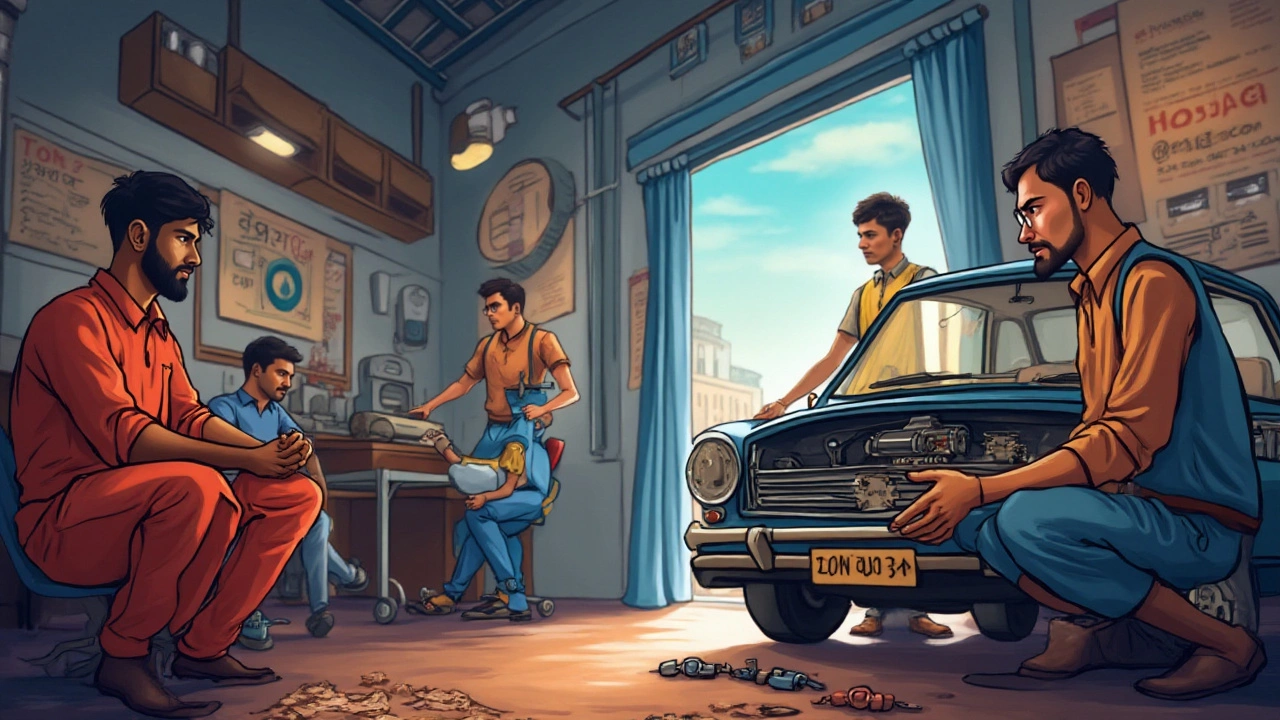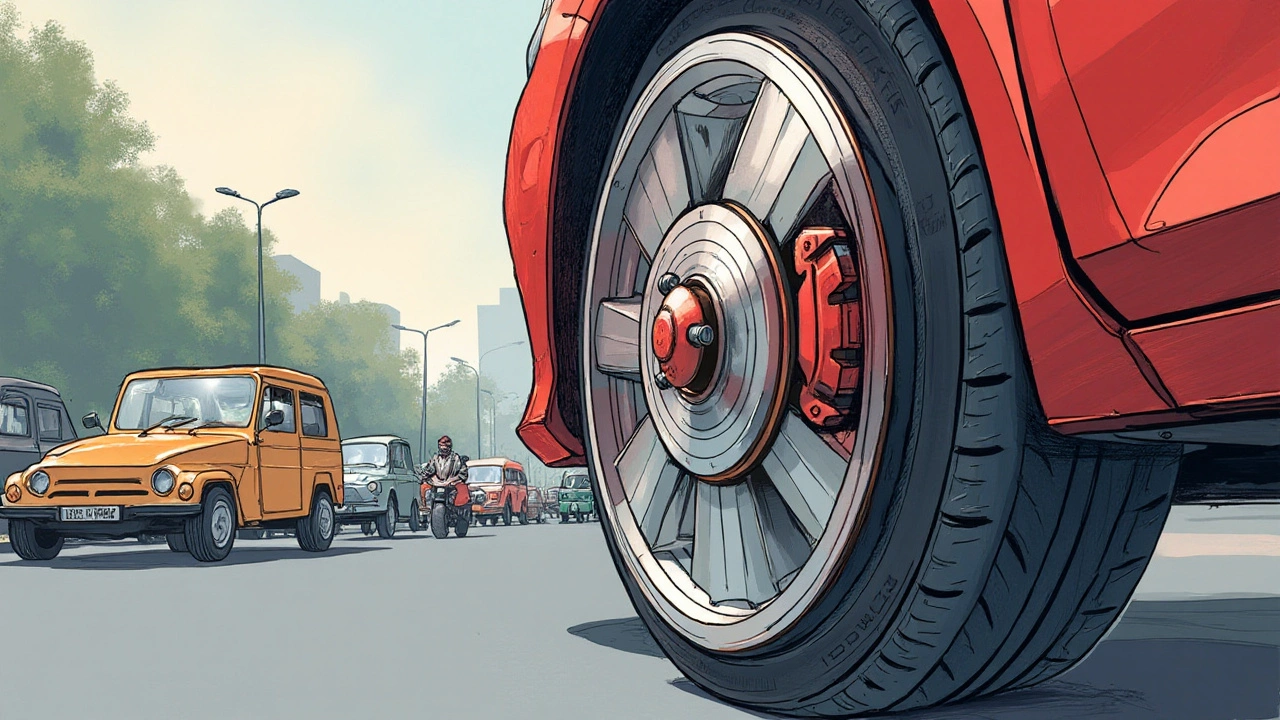 Feb, 4 2025
Feb, 4 2025
Brake pads—they're not just an afterthought when it comes to vehicle safety. Picture this: you're driving along with your favorite tunes, when suddenly, you need to make an abrupt stop. It’s your brakes that save the day, and behind that heroic halt are your trusty brake pads. But when they wear down, as they inevitably do, the question arises—do you swap all four at once or just address the squeaky wheels?
This decision isn’t as straightforward as it might appear. It's a blend of safety, performance, and value for your hard-earned money. Your car’s braking system is more complex than it seems, and understanding how it functions can make all the difference. Join us as we delve into the nitty-gritty of brake pad wear, the signals your car sends, and the practicalities of replacement. Whether you're a gearhead or just a concerned driver, this article could be your next pit stop for all things brake-related!
- Understanding Brake Pad Wear
- Signs of Brake Pad Deterioration
- Pros and Cons of Replacing All Four
- Cost Considerations
- When to Seek Professional Advice
Understanding Brake Pad Wear
When it comes to maintaining your vehicle, brake pads often sit high on the priority list. These unsung heroes endure significant stress every time you stop your car, converting kinetic energy into heat to slow down effectively. But what causes these essential components to wear out, and how can you identify when it's time for fresh ones?
The Anatomy of Brake Pads
Brake pads are part of your car’s disc braking system, typically consisting of a metal backing plate with friction material bound to its surface. When you apply the brakes, these pads clamp down against the brake rotor, creating friction that transforms the car’s momentum into thermal energy. Over time, this friction wears down the pads, necessitating their replacement.
Factors Influencing Wear
Not all brake pads wear equally, and several factors can impact their lifespan:
- Driving Habits: Aggressive or frequent braking accelerates wear. If you're a city driver who often faces stop-and-go traffic, you might find yourself replacing brake pads more frequently than someone who sticks to the highway.
- Material Quality: Brake pads come in various materials, including organic, semi-metallic, and ceramic. Each type offers trade-offs between cost, performance, and durability. For instance, ceramic pads, while more expensive, often last longer and perform quietly.
- Vehicle Type: Larger vehicles like SUVs or trucks put more strain on brake systems compared to smaller cars. The additional weight can lead to faster wear and tear of the pads.
- Road Conditions: Driving in mountainous areas or regions with lots of curves requires more frequent braking, putting additional strain on the brake pads.
Recognizing the Signs of Wear
Knowing your brake pads' condition is crucial for safety. Here are some indicators that your brake pads might be due for replacement:
- Squealing Noise: This is often the first sign—a high-pitched sound from the wheels indicates pads are wearing thin. Built-in wear indicators create this noise as a preventive measure.
- Vibrations: If you notice a vibration or pulsation when braking, it could be a sign that pads are unevenly worn or that the rotors are warped.
- Increased Stopping Distance: If you find it takes longer to stop, despite having adequate pedal pressure, your pads may be past their prime.
- Visual Inspection: If the pad is visually less than a quarter-inch thick, it’s time to plan a replacement.
Keeping an eye on these factors can help maintain the efficiency and safety of your car's braking system. After all, understanding brake pad wear isn’t just about extending the life of your vehicle parts; it’s about keeping you and your passengers safe on the road.
Signs of Brake Pad Deterioration
Your car speaks to you—just not always in words. One of the ways it communicates is through your brake pads. Over time, these essential components wear down, and recognizing the signs early can save you from unexpected repairs and keep you safe on the road.
1. Squealing or Squeaking Sounds
One of the earliest and most common indicators that your brake pads are wearing out is a high-pitched squeal. This noise typically arises when the pads are too thin. Most brake pads include a small metal indicator that creates this sound when the pad has worn down to an unsafe level.
2. Reduced Responsiveness
If you notice a delay when you press the brake pedal, or if it feels unusually hard or spongy, it might be due to deteriorated brake pads. This reduced responsiveness is a sign that your braking system might not perform as needed in an emergency situation.
3. Metallic Grinding Noise
A grinding sound when brakes are applied generally means it's too late. This noise indicates that the brake pads are worn away completely and now metal is grinding on metal, which can score or damage your rotors, leading to more costly repairs.
4. Vibration or Pulsation
A telltale sign of potential braking system trouble is a vibration or pulsation in the brake pedal or steering wheel. This can occur when brake pads are worn unevenly or when a rotor is warped.
5. Visual Check
For those who don't mind getting a bit hands-on, a visual inspection of the brake pads can reveal a lot. If the pads appear to be less than a quarter-inch thick, it's time to consider replacement.
Keeping Track
The life of brake pads can vary widely based on the type of vehicle, driving conditions, and braking habits. While some pads can last up to 70,000 miles, others may need replacement as early as 25,000 miles. To help you anticipate brake pad life, here's a rough breakdown:
| Driving Conditions | Expected Brake Pad Life |
|---|---|
| Normal highway driving | 50,000 - 70,000 miles |
| City driving (frequent stops) | 30,000 - 50,000 miles |
| Aggressive driving | 20,000 - 30,000 miles |
With a keen ear and a watchful eye, you can keep tabs on the health of your brake pads and steer clear of more expensive repairs. Remember, when it comes to brakes, waiting until they’re completely worn out isn’t an option you want on the table.

Pros and Cons of Replacing All Four
When it comes to brake maintenance, the question of whether to replace all four brake pads at once is more common than you might think. Each option carries its own set of advantages and potential drawbacks, and understanding these can help you make the best decision for your vehicle.
The Pros of Replacing All Four Brake Pads
There are several reasons why replacing all four brake pads simultaneously can be beneficial:
- Consistent Braking Performance: Changing all four pads ensures that each wheel has the same braking material, leading to uniform wear and consistent stopping power across the entire vehicle. This is especially important in emergency braking situations where vehicle stability is crucial.
- Safety: New pads provide optimal friction, reducing stopping distances and enhancing overall safety. Consistent pad material across all wheels can prevent one set of wheels from experiencing greater wear or stress.
- Long-Term Cost Efficiency: Although initially more expensive, changing all pads at once can be more cost-effective over time. It prevents uneven wear and tear, potentially reducing the frequency of replacements and other maintenance issues like rotor damage.
The Cons of Replacing All Four Brake Pads
However, there are also downsides to this approach:
- Higher Initial Cost: The most obvious downside is the immediate expense. Changing all four pads requires a bigger upfront investment, which might be unnecessary if only some pads have worn down.
- Unnecessary Replacement: If the rear brake pads are still in good condition, replacing them might not be necessary. Rear brake pads typically wear down slower than front pads, as front brakes handle the majority of stopping force.
- Time-Consuming: Coordinating the replacement of all four pads might require more time at the shop or more effort if you're doing it yourself.
Finding a Balance
The choice often depends on your driving habits, the type of vehicle, and the advice of your trusted mechanic. It's recommended to routinely check the condition of the brake pads during regular maintenance appointments. Note that front brake pads tend to wear out faster due to the dynamics of stopping and might require more frequent attention.
Replacing all four brake pads can certainly provide peace of mind and better long-term performance, but it should be weighed against the cost and necessity based on current pad conditions. Ultimately, making an informed decision can lead to a safer, more enjoyable driving experience.
Cost Considerations
When it comes to replacing your vehicle’s brake pads, the decision often hinges on your budget. But let's face it, skimping on this vital component might end up costing more in the long run. So, how do you navigate these waters wisely? Let's break down the cost factors and explore the monetary implications of replacing one, two, or all four brake pads.
Comparing Costs: Single vs. Full Replacement
At the heart of this decision is the cost difference between addressing an issue on a single wheel versus performing a comprehensive upgrade on all four. Replacing brake pads individually might seem more economical upfront. Depending on your car's make and model, a single wheel's brake pad replacement can cost anywhere from $150 to $300, including labor.
On the other hand, going for all four—while typically higher in immediate costs—offers uniform performance and can save on labor fees in the future. On average, replacing all four brake pads could set you back around $300 to $800. The potential for wear-and-tear reduction on other brake system components might also mean fewer trips to the mechanic down the line.
Labor and Parts: A Balancing Act
Labor charges make up a significant portion of brake pad replacement costs. If you're paying a professional, doing more at once often reduces the cumulative cost compared to scheduling multiple visits. There’s also the added peace of mind that comes with replacing all four, knowing each brake pads provides consistent performance.
| Type of Replacement | Cost Range (per axle) | Total Cost for Four |
|---|---|---|
| Individual Replacement | $150 - $300 | $600 - $1200 |
| Full Replacement | $300 - $800 | $300 - $800 |
Factor in Your Driving Habits
Your own driving habits are an often-overlooked factor in cost considerations. Frequent stop-and-go traffic, driving in hilly areas, or a propensity for heavy braking can accelerate wear, tipping the scales toward the necessity of all-at-once replacements. Those who cruise primarily on highways might find less frequent changes more financially viable.
The DIY Dilemma
If you're mechanically inclined, consider doing the swap yourself to save money. Quality brake pads can be bought for $50 to $150 per set, but remember, this task requires certain skills and tools. The risks should be weighed carefully—incorrect installation can lead to uneven wear or even failure, which can compromise safety and cost more to fix.
In sum, while the sticker shock of replacing all four brake pads might seem daunting, balancing this expense against long-term savings and safety provides a clearer picture. Driving with confidence comes at a price, but it's one that can be measured in both dollars and peace of mind.

When to Seek Professional Advice
Your car's braking system is a crucial safety component that often requires professional insight to ensure optimal performance. While some enthusiasts might prefer a DIY approach, recognizing when to consult a professional can be the key to maintaining a safe vehicle.
Uneven Brake Pad Wear
One telltale sign that it’s time to call in the pros is uneven brake pad wear. If one side appears more worn than the other, it could indicate an issue with calipers or disc alignment. A skilled mechanic will diagnose the problem accurately, preventing future complications.Persistent Noise During Braking
Persistent noises, such as grinding or high-pitched squeals, suggest it's time for a professional inspection. These sounds often indicate the metal backing of a worn pad is contacting the rotor. Left unchecked, this could damage the rotor, leading to a much costlier repair.Brake Warning Lights
If your car’s dashboard displays a brake warning light, don’t dismiss it. Modern vehicles often use sensors to monitor brake wear, and ignoring these alerts can compromise safety. A professional evaluation ensures the underlying issue is identified and resolved quickly.Vibrations or Pulsations
Experiencing vibrations or pulsations when braking might suggest warped rotors or misaligned pads. A professional has the tools and expertise to accurately assess the cause and will recommend the right solution to restore your car's braking efficiency.Regular Maintenance
Regular maintenance is crucial in extending the lifespan of your brake system. According to NHSTA studies, routine brake inspections can reduce the risk of accidents by up to 25%. Professional mechanics offer comprehensive inspections, spotting potential issues before they become significant threats.So, when in doubt about your vehicle's brake pads or if something just doesn't feel right, seeking professional advice is the best route. It ensures your car runs smoothly, but more importantly, it keeps you and your loved ones safe on the road.